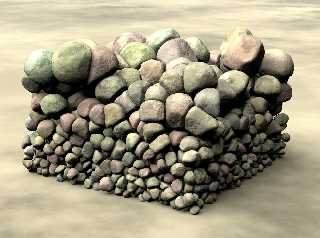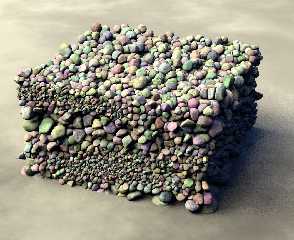 |
 |
|
 |
|
 |
|  |
|  |
|
 |
|
 |
|  |
|  |
|
 |
Hi again!
I found a way to allow grains of different sizes to placed, and the results
aren't so bad! All I needed to do was to subtract blob components with sizes
*relative* to the grain being produced. To do /that/, however, required an extra
loop in which all neighboring point distances were added up and averaged to
determine an acceptable size for the current grain.
Voronoi calculation time for scene: about 3 seconds. Parse time: 3 seconds.
Render time with one 12x12 area-illuminating area light: 10 minutes 6 seconds.
Not too bad!
The biggest problem I can see is that some grains (other than those assumed to
be held up by walls) appear to float. These are so few, and the parsing time so
short, that for a final scene grains could be placed manually to make it look
physically-correct.
I'd love to make this available to everyone, but I don't know where to start :(
I could just drop some source/binaries and hope for the best...
Sam
Post a reply to this message
Attachments:
Download '2296-grains.jpg' (100 KB)
Preview of image '2296-grains.jpg'

|
 |
|  |
|  |
|
 |
|
 |
|  |
|  |
|
 |
In sedimentological terms, this would be an inversely graded set consisting
of moderately sorted, moderately to badly rounded, medium to very coarse
sand with cobble-sized elements... Oh well, don't make me repeat myself too
often, please ;-)
Thomas
Post a reply to this message
|
 |
|  |
|  |
|
 |
|
 |
|  |
|  |
|
 |
On 4/3/2011 12:59 AM, Thomas de Groot wrote:
> In sedimentological terms, this would be an inversely graded set consisting
> of moderately sorted, moderately to badly rounded, medium to very coarse
> sand with cobble-sized elements... Oh well, don't make me repeat myself too
> often, please ;-)
Your, ahem, expertise in this field is appreciated ;P
Post a reply to this message
|
 |
|  |
|  |
|
 |
|
 |
|  |
|  |
|
 |
Continuing in the same vein...
I was over-complicating each blob's influence, and it was causing the
smaller particles to become too spaced.
Here's a set of over 27,000 particles. Variable particle density was
used to give the appearance of strata. Parse time was around 30 seconds,
render time was 6 minutes, 18 seconds.
This will be it for while, at least until I can take it to the next
level. Hopefully I'll get this working with spherical objects, at which
point things like gumball machines and granular flow will become
possible (realistic avalanches might even become a possibility).
If nothing else, it's a highly entertaining way to spend my time :)
Sam
Post a reply to this message
Attachments:
Download '27841-grains.jpg' (115 KB)
Preview of image '27841-grains.jpg'

|
 |
|  |
|  |
|
 |
|
 |
|  |
|  |
|
 |
"stbenge" <"egnebts <-inverted"@hotmail.com> schreef in bericht
news:4d98c261$1@news.povray.org...
> Your, ahem, expertise in this field is appreciated ;P
Whatever it is worth in the POV-Ray world... ;-)
Thomas
Post a reply to this message
|
 |
|  |
|  |
|
 |
|
 |
|  |
|  |
|
 |
Better and better!
You know, Sam, this is very like RL. I just cannot help myself to see a
river bed here. I hope you will develop further along these lines. Great
work, as usual.
Thomas
Post a reply to this message
|
 |
|  |
|  |
|
 |
|
 |
|  |
|  |
|
 |
This looks awesome, and the technique is very elegant! I look forward to further
developments.
I think it could be adapted to make excellent drystone walls.
Bill
Post a reply to this message
|
 |
|  |
|  |
|
 |
|
 |
|  |
|  |
|
 |
>Samuel Benge on date 03/04/2011 02:09 wrote:
> Hi again!
>
> I found a way to allow grains of different sizes to placed, and the results
> aren't so bad! All I needed to do was to subtract blob components with sizes
> *relative* to the grain being produced. To do /that/, however, required an extra
> loop in which all neighboring point distances were added up and averaged to
> determine an acceptable size for the current grain.
>
> Voronoi calculation time for scene: about 3 seconds. Parse time: 3 seconds.
> Render time with one 12x12 area-illuminating area light: 10 minutes 6 seconds.
> Not too bad!
>
> The biggest problem I can see is that some grains (other than those assumed to
> be held up by walls) appear to float. These are so few, and the parsing time so
> short, that for a final scene grains could be placed manually to make it look
> physically-correct.
>
> I'd love to make this available to everyone, but I don't know where to start :(
> I could just drop some source/binaries and hope for the best...
>
> Sam
I like e lot the colors of these grains.
;-)
Paolo
Post a reply to this message
|
 |
|  |
|  |
|
 |
|
 |
|  |
|  |
|
 |
so very awesome. We can always say the floating particles were actually
caught midair from a fall.
--
a game sig: http://tinyurl.com/d3rxz9
Post a reply to this message
|
 |
|  |
|  |
|
 |
|
 |
|  |
|  |
|
 |
Very impressive!
So, if these are blobs the roughness is just texture?
Reading up a bit on Voronoi diagrams I found this
entertaining interactive web application:
http://www.pi6.fernuni-hagen.de/GeomLab/VoroGlide/
Post a reply to this message
|
 |
|  |
|  |
|
 |
|
 |
|  |




![]()